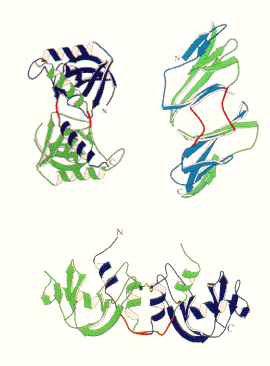
3D Domain swapping: A mechanism for oligomer assembly
3D domain swapping is a mechanism for forming oligomeric proteins from their monomers. In 3D domain swapping, one domain of a monomeric protein is replaced by the same domain from an identical protein chain. The result is an intertwined dimer or higher oligomer, with one domain of each subunit replaced by the identical domain from another subunit. The swapped "domain" can be as large as an entire tertiary globular domain, or as small as an alpha-helix or a strand of a beta-sheet. Examples of 3D domain swapping are reviewed that suggest domain swapping can serve as a mechanism for functional interconversion between monomers and oligomers, and that domain swapping may serve as a mechanism for evolution of some oligomeric proteins. Domain-swapped proteins present examples of a single protein chain folding into two distinct structures.
Swapped domain -
A swapped domain in a protein oilgomerisa globular domain that is interteined with an identical protein chain, with the seapped domain having an enviroment essentially identical to that of same domain in a protein monomer.
Hinge loop -
A segment of polypeptide chain that links the swapped domain to the rest of its subunit is a hinge loop. Hinge loops have different conformations in monomers and domain-swapped oligomers.
C-interface -
A C-interface occurs between domains in a monomeric subunit (closed monomer).
3D domain-swapped dimer -
A dimer with a two C-interfaces between two different subunits (open monomers) is a 3D domain-swapped dimer.
O interface -
An O-interface occurs between open monomers in a 3D domain-swapped dimer, NOT present in the closed monomer.
Next
PC Lyu